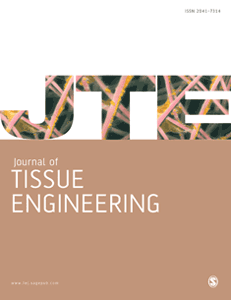根据骨损伤环境的炎症模式及时输送骨髓间充质干细胞,促进大鼠腓骨缺损的修复:骨组织工程的优化策略
IF 6.7
1区 工程技术
Q1 CELL & TISSUE ENGINEERING
引用次数: 0
摘要
干细胞疗法在修复骨缺损方面发挥着重要作用。然而,骨组织工程中传统的干细胞移植策略存活率低,治疗效果不稳定。在本研究中,我们提出了一种针对骨损伤时炎症变化的及时输送策略,以提高移植细胞的存活率和骨修复效果。体内细胞追踪结果显示,该策略能有效提高低剂量外源移植细胞在骨缺损区的存活率,CD31免疫荧光和组织学切片显示,该策略能有效促进腓骨缺损区的血管化和新骨形成。随后,我们从炎症微环境调控的角度分析了 "两步走 "策略的作用机制,结果表明,第一批移植的干细胞会引起局部一过性的组织凋亡水平和炎症因子升高,并诱导巨噬细胞趋化,第二批细胞可能会促进组织的促炎-抗炎转化。最后,mRNA 测序结果表明,"两步法 "策略中的第一批细胞是骨修复的重要启动因子,不仅能积极调节骨缺损处的免疫微环境,还能引导更丰富的细胞活性和更积极的生化反应。因此,"两步法 "策略能有效调节炎症环境,达到良好的骨修复效果,为今后治疗骨缺损提供了另一种选择。本文章由计算机程序翻译,如有差异,请以英文原文为准。
Timely delivery of bone marrow mesenchymal stem cells based on the inflammatory pattern of bone injury environment to promote the repair of calvarial bone defects in rats: An optimized strategy for bone tissue engineering
Stem cell-based therapy plays a significant role in the repair of bone defects. However, traditional stem cell transplantation strategies in bone tissue engineering are characterized by low survival rates and unstable treatment outcomes. In this study, we propose a timely delivery strategy for inflammatory changes in the setting of bone injury to improve the survival rate of transplanted cells and bone repair. The results of cell tracing in vivo showed that this strategy could effectively improve the survival rate of low-dose exogenous transplanted cells in bone defect areas, and CD31 immunofluorescence and histological sections suggested that this strategy effectively promoted vascularization and new bone formation in the calvarial defect area. Subsequently, we analyzed the mechanism of action of the “Two-step” strategy from the perspective of inflammatory microenvironment regulation, and the results suggested that the first batch transplanted stem cells caused localized and transient increases in tissue apoptosis levels and inflammatory factors, and recruited macrophage chemotaxis, and the second batch of cells may promote pro-inflammatory - anti-inflammatory transformation of the tissue. Finally, mRNA sequencing results suggest that the first batch cells in the “Two-step” strategy are important initiators in bone repair, which not only actively regulate the immune microenvironment at the bone defect, but also guide richer cellular activity and more positive biochemical responses. Therefore, the “Two-step” strategy leads to efficient inflammatory environment regulation and superior bone repair effects, which may provide an alternative option for the treatment of bone defects in the future.
求助全文
通过发布文献求助,成功后即可免费获取论文全文。
去求助
来源期刊

Journal of Tissue Engineering
Engineering-Biomedical Engineering
CiteScore
11.60
自引率
4.90%
发文量
52
审稿时长
12 weeks
期刊介绍:
The Journal of Tissue Engineering (JTE) is a peer-reviewed, open-access journal dedicated to scientific research in the field of tissue engineering and its clinical applications. Our journal encompasses a wide range of interests, from the fundamental aspects of stem cells and progenitor cells, including their expansion to viable numbers, to an in-depth understanding of their differentiation processes. Join us in exploring the latest advancements in tissue engineering and its clinical translation.
 求助内容:
求助内容: 应助结果提醒方式:
应助结果提醒方式:


